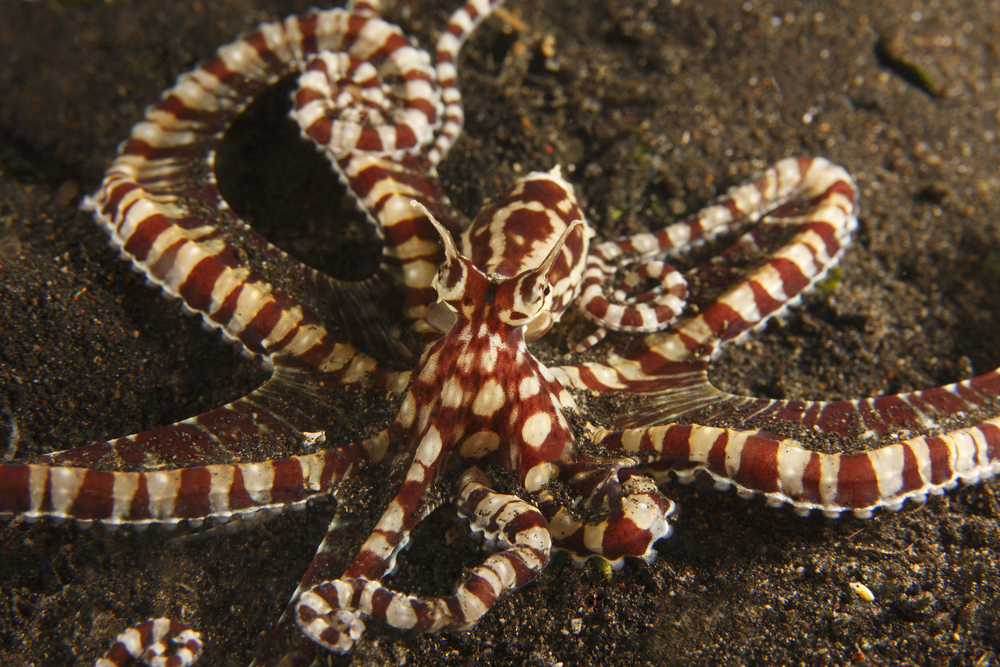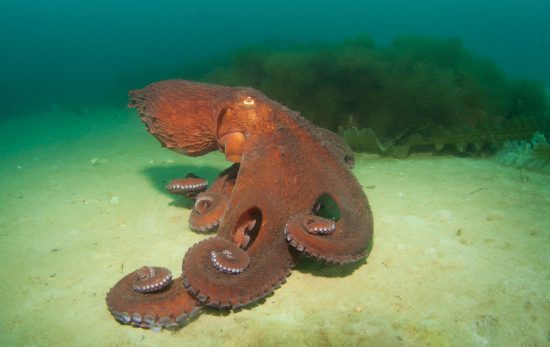A scuba diver’s logbook isn’t complete without an octopus encounter. So, what are the best destinations for octopus diving? In this article, we introduce eight different species and eight incredible places where you can expect to dive with these eight-armed wonders.
Octopuses (and yes, that’s the correct plural) first appeared on Earth around 300 million years ago. They’ve since been the subject of many a legend, folklore, and sea shanty, where sailors report colossal monsters attacking ships out of nowhere.
In reality, most octopuses are quite small and prefer to wait until dark before creeping out to find a meal. Their shy and reclusive manner, coupled with unrivaled octopus camouflage skills, makes them one of the trickier marine creatures for divers to spot and photograph, and for scientists to study. But, they can be found in every ocean across the globe, and if you visit the right places at the right time, an octopus encounter is almost certain.
Here are some of the best destinations for octopus diving, plus a few tips on how to find octopus while diving there.
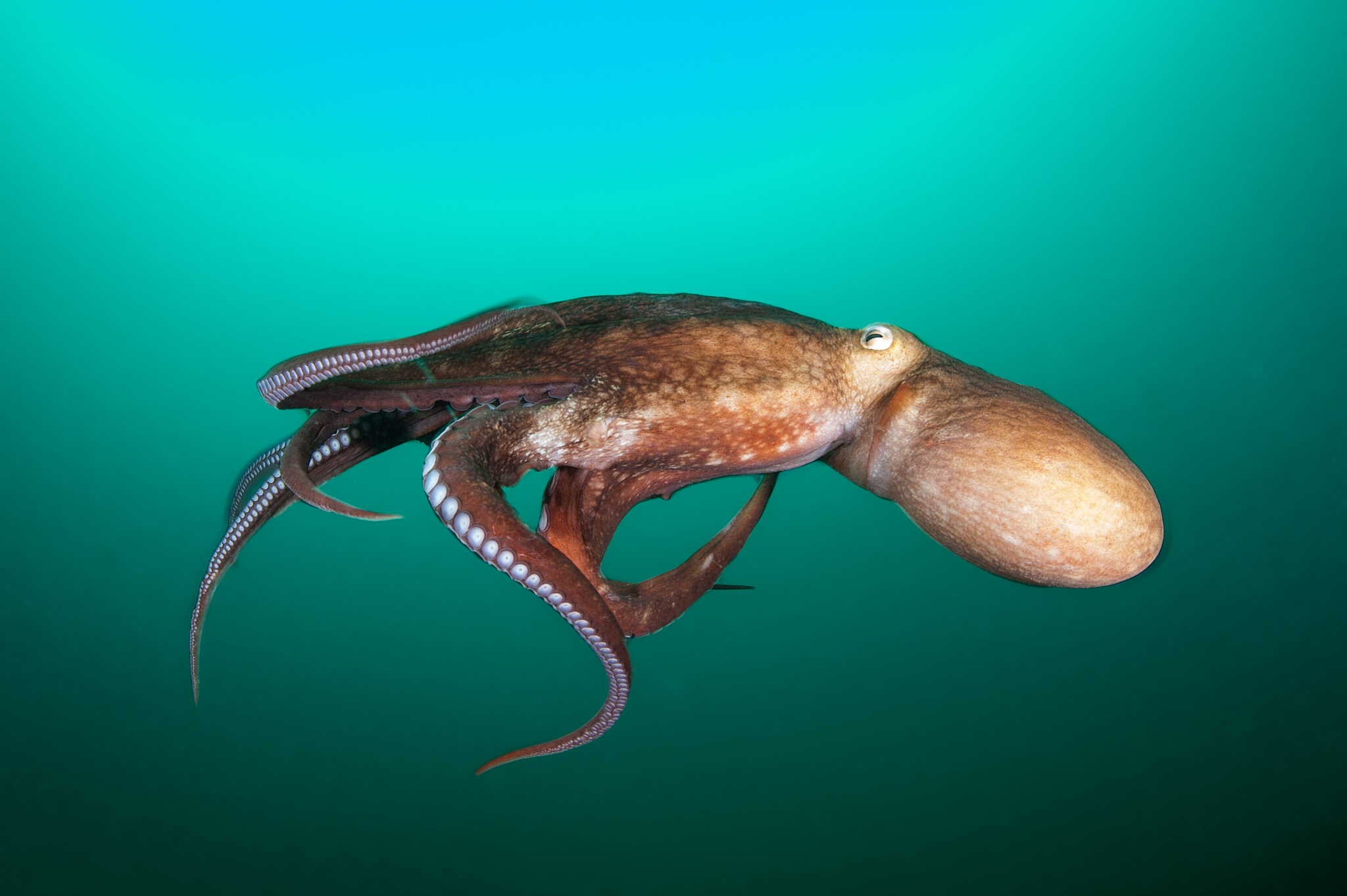
Octopus facts
Octopuses are part of the cephalopod family (which also includes cuttlefish, squid, and nautilus). There are around 300 different types of octopus! With a highly advanced nervous system, they are admired for their ability to change color and texture for camouflage and communication. In the blink of an eye, they can transform from a flashing light show to complete invisibility. What’s more, octopuses have three hearts, blue blood, and can re-grow limbs. It’s no wonder people call them aliens!
The more we learn about octopuses, the more reasons there are to adore and respect them. Indeed, they never fail to captivate people around the world. Videos and stories from marine biologists and scuba divers have shown just how intelligent these critters are. How about taking octopus selfies or escape artistry in Seattle?
Keep reading for the best destinations for octopus diving.
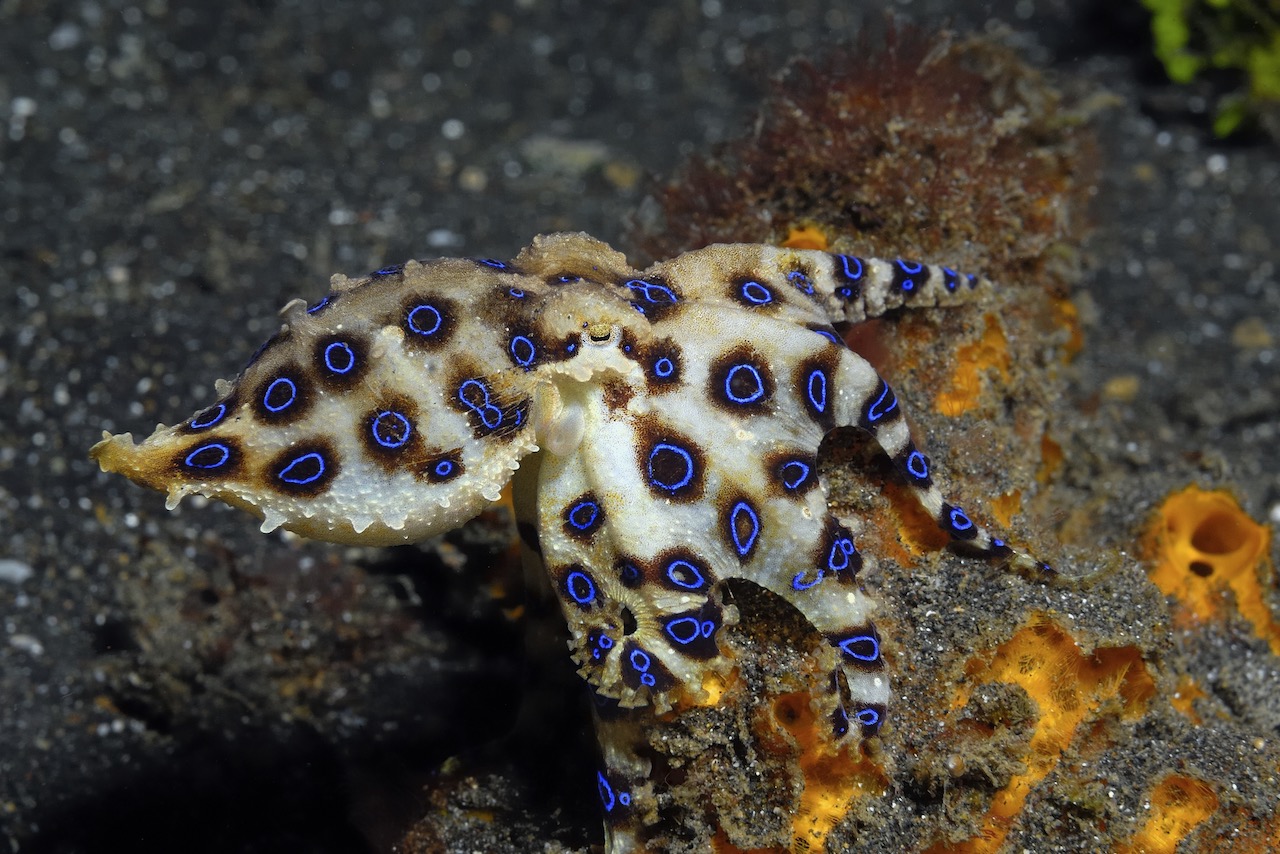
1. Blue-ringed octopus: Mabul, Malaysia
Despite being as little as 2 inches (5cm) long – even with its arms stretched out – this striking invertebrate is instantly recognizable thanks to its vivid, ringed pattern. The four known species of blue-ringed octopus (Hapalochlaena, aka BRO) are named after the density and variation of their rings. The most common are the lesser blue-ringed octopus and the greater blue-ringed octopus.
The blue-ringed octopus is generally docile, but it’s also the world’s deadliest octopus. When provoked, its self-defense is a killer bite filled with tetrodotoxin. It’s the same substance found in other toxic critters, such as pufferfish and cone snails. It’s said just 1 milligram is enough to kill an adult human. There’s also no antidote, so we really can’t stress this enough: look, but definitely do not touch!
Our favorite blue-ringed octopus destination:
Sipadan, Malaysia, is one of the best destinations for octopus in the ocean, including the famous blue-ringed variety. In particular, the house reef at Seaventures Dive Rig provides a relaxed location where divers have plenty of time to search for this bucket-list species among the many corals and crevices. Macro photographers will especially enjoy the challenge of spotting and shooting these underwater icons alongside a plethora of other bright and beautiful reef inhabitants.
Editor’s Recommended Dive Resort: Seaventures Dive Rig
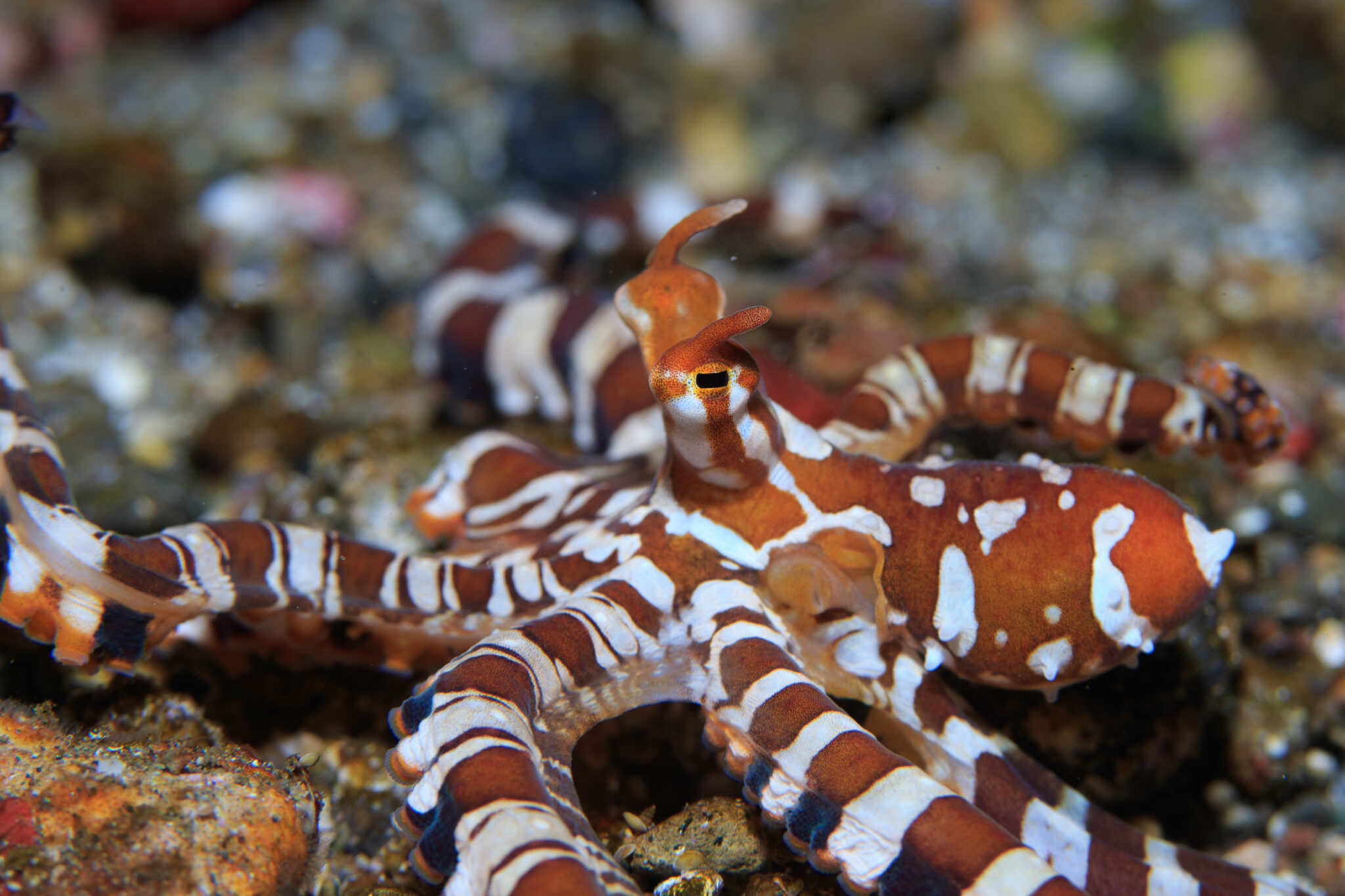
2. Wonderpus octopus: Anilao, Philippines
Wonder by name, wonder by nature: this fascinating species (Wunderpus photogenicus) is relatively new to marine biologists. Named after the German word for ‘wonder’ or ‘marvel’, much of this octopus’ lifestyle and behaviors are still a mystery.
In shades of orange, red, or brown, with white spots and stripes, the wonderpus is often mistaken for the similar-looking mimic octopus. In fact, some scientific theories suggest its resemblance to other venomous critters, such as lionfish and sea snakes helps to ward off danger. When threatened, the wonderpus is also thought to intensify its hue and patterns as a warning to hungry hunters.
Our favorite wonderpus octopus destination:
Anilao, Philippines, is a top place to see the wonderpus octopus. During daytime, the small mollusk takes shelter by digging holes in the seabed or choosing a suitable burrow left by another creature. The best sightings come during a dawn or dusk dive. At these times, this eight-armed entertainer might be seen swimming — or even ‘walking’ — across the seabed as it searches for food. Meanwhile, as one of the planet’s best muck diving destinations, you’ll be sure to experience countless other macro moments in Anilao’s waters.
Editor’s Recommended Dive Resort: Blue Ribbon Dive Resort
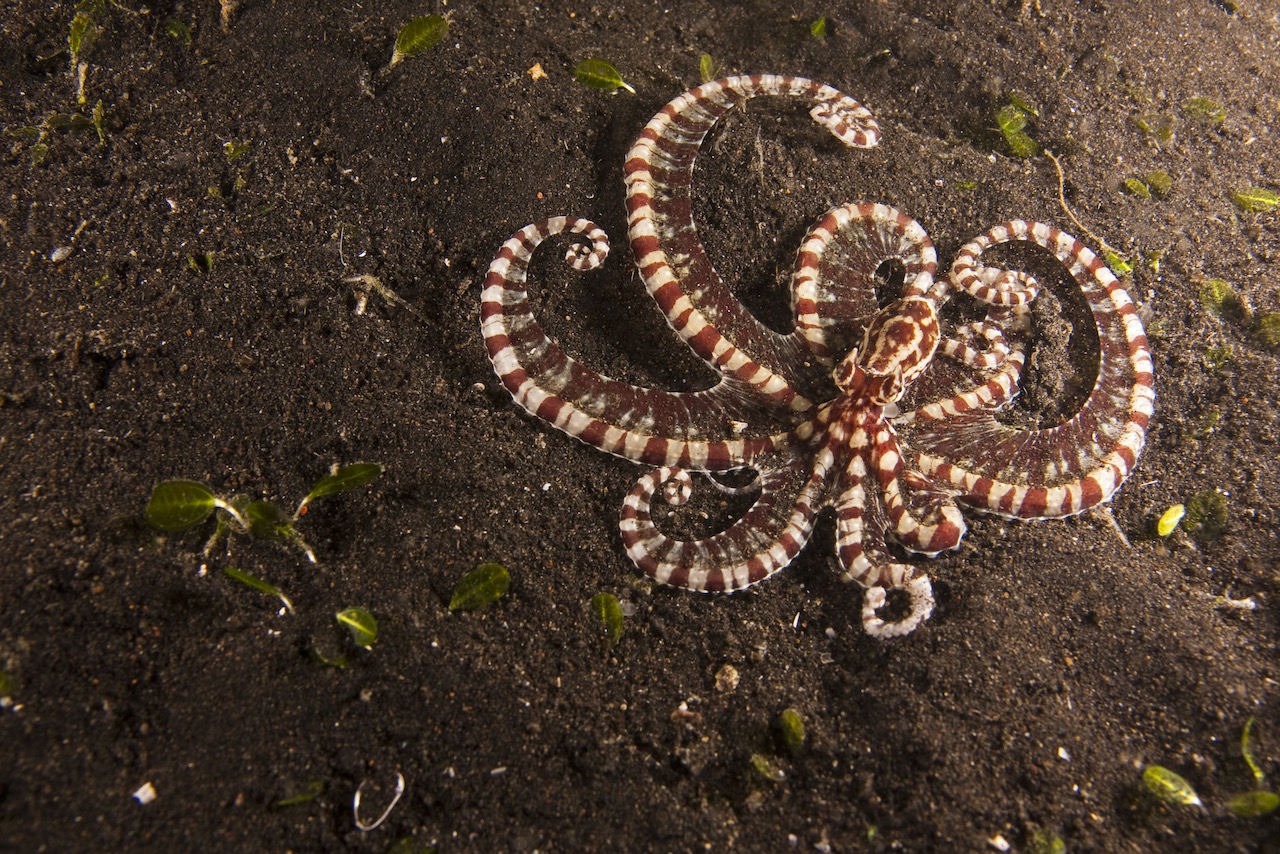
3. Mimic octopus: Tawali, Papua New Guinea
As its name suggests, the mimic octopus (Thaumoctopus mimicus) is a master of deception and mimicry. Although it closely resembles the wonderpus octopus, it has darker shading and can fully conceal its stripes for more effective camouflage.
Cephalopods typically change their appearance to blend into their background. However, the mimic octopus is the only one that deliberately impersonates other marine life. Since it’s active during the day (when many predators are also out and about), this is a useful survival talent. What’s even more impressive is that the mimic octopus will copy one of around 15 different creatures, depending on who it needs to hide from. This includes:
- Flatfish – by flattening its body with its arms held close together.
- Lionfish – by free swimming and holding its arms out to mimic a lionfish’s fins.
- Sea snake – by burying itself in a hole, leaving only two arms in view — snake style!
Other mimic octopus disguises include jellyfish, shrimp, anemones, and even crabs.
Our favorite mimic octopus destination:
If you’re wondering where to dive with mimic octopus, head to the southeast coast of Papua New Guinea. Tawali is a Pacific gem and one of the best destinations for octopus diving. Plus, there are plentiful muck and macro dive sites. Alongside idyllic island views, the underwater vistas are sure to impress with dramatic walls and pinnacles. The ocean floor is covered with flora and fauna — so you may need to look twice if you’re searching for a mimic octopus!
Editor’s Recommended Dive Resort: Tawali Leisure and Dive Resort
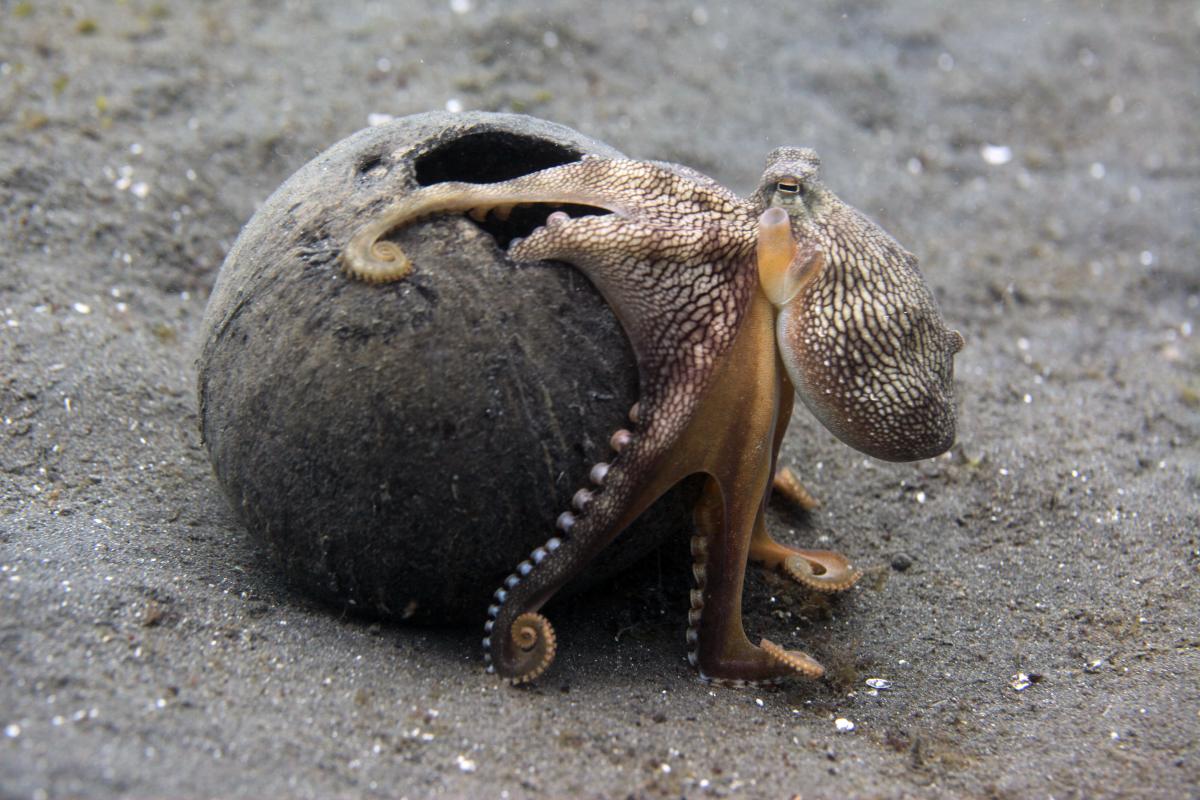
4. Coconut octopus: Sulawesi, Indonesia
When you see photos or videos of this comical, medium-sized octopus, it won’t be a surprise to learn how it earned its name. The coconut octopus (Amphioctopus marginatus) — also known as the veined octopus — is renowned for collecting and hiding inside empty coconut shells (or sometimes even seashells) with only an arm or eye peeking out. It’s also been observed carrying these shells as it skims across the sea floor — something akin to octopus armor!
The coconut octopus is a tropical species that lives in the western Pacific Ocean. You’ll most likely find it along coastlines where palm trees and local villagers discard coconut shells into the ocean. These shallow, muddy waters provide rich pickings for octopus real estate!
Our favorite coconut octopus destination:
One of the best destinations for octopus diving is Lembeh, North Sulawesi in Indonesia. Here, thriving green lands meet with oceans filled with life. Muck divers and macro photographers alike will revel in the abundance of species such as nudibranchs, hairy frogfish, squid, crabs, and mantis shrimp. If you stumble across a coconut shell, do take a closer look. You might just find a curious octopus peering back at you!
Editor’s Recommended Dive Center: Two Fish Divers Lembeh
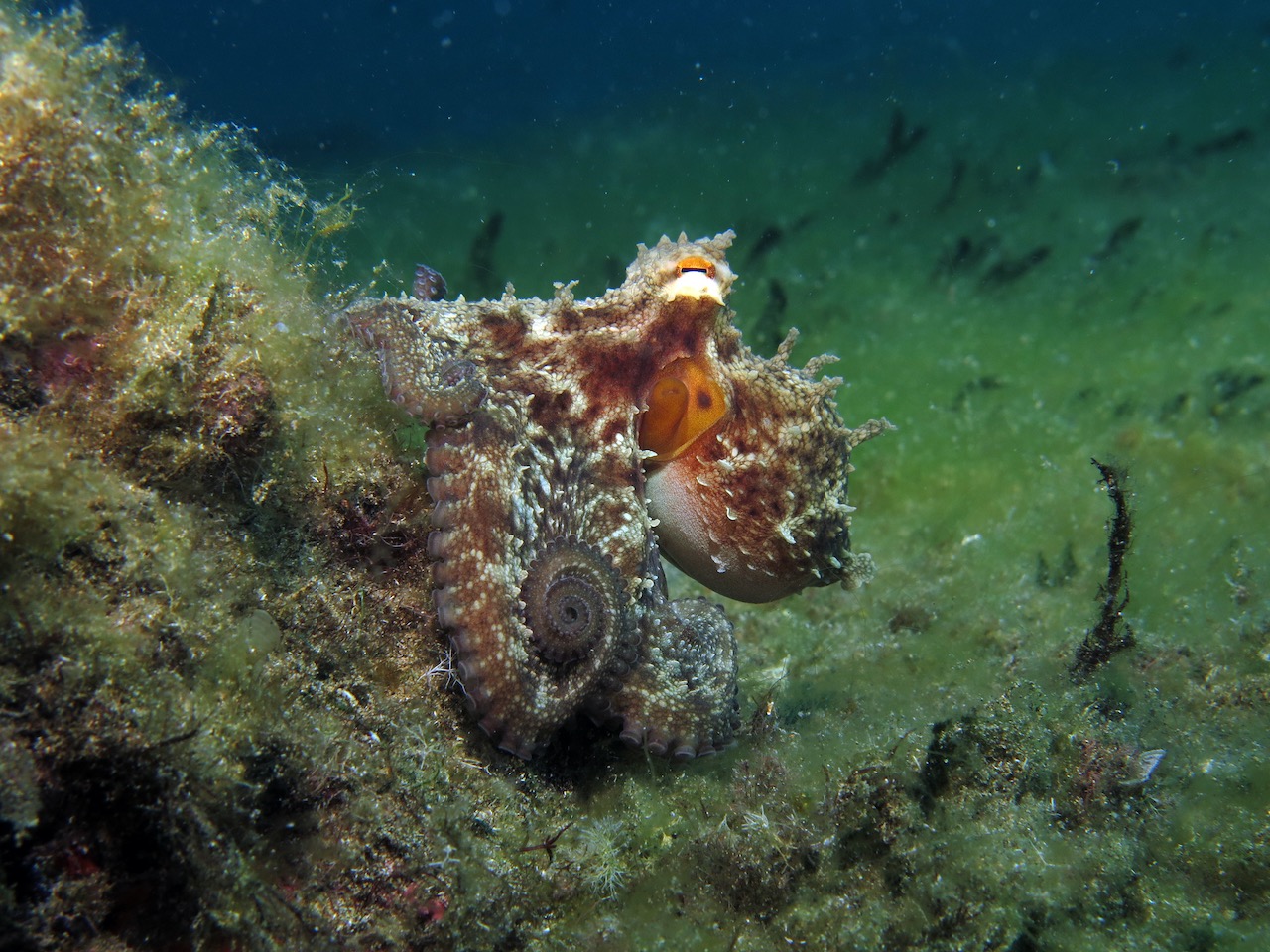
5. Common octopus: Canary Islands, Spain
The widespread Octopus vulgaris is indeed a common species of octopus. So common, in fact, that scientists now believe there might be up to ten different sub-species. With an arm span that can reach 1m (3ft), it’s a large octopus and easily identified with its massive head and big eyes.
The common octopus is shy but well-studied, and its prevalence across many parts of the world has allowed marine biologists to gain insight into many cephalopod traits and characteristics. For example, in addition to their masterful camouflage, octopuses squirt ink to disorientate predators, giving them time to escape. They’re also super-fast (thanks to natural jet propulsion) and can squeeze through the smallest of gaps with ease. Common, yes — but no less extraordinary!
Our favorite common octopus destination:
Where can you see Octopus vulgaris? You can spot them across the oceans, from tropical to temperature waters and from the western Atlantic to the Mediterranean. However, the Canary Islands is one of the best destinations for an octopus dive against a backdrop of beautiful reefs and wrecks. Look out, too, for memorable meetings with stingrays, bream, wrasse, and trumpet fish.
Editor’s Recommended Dive Resort: Holiday Club Puerto Calma
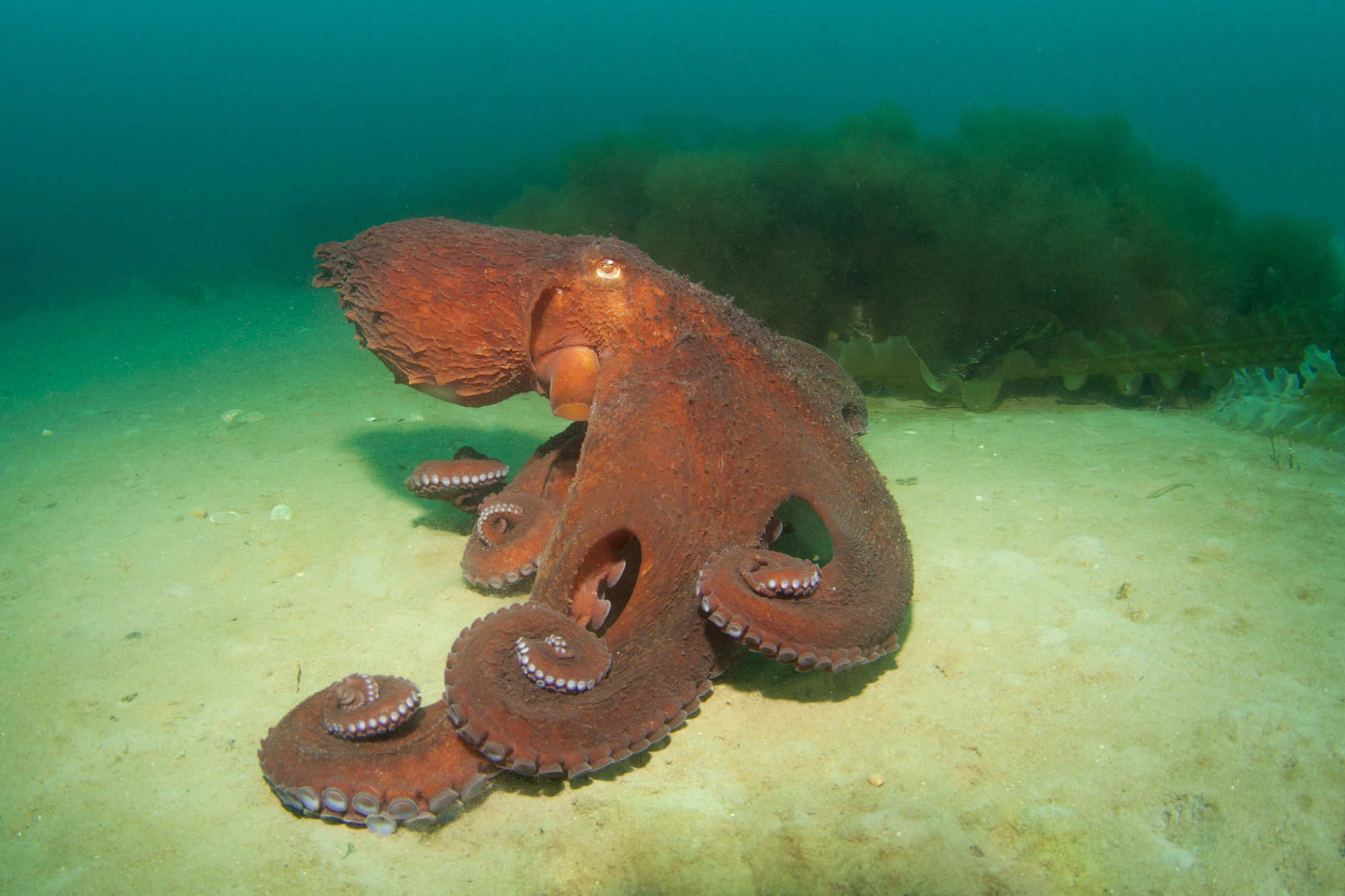
6. Giant Pacific octopus: Vancouver Island, Canada
The reddish-brown giant Pacific octopus (Enteroctopus dofleini) is undoubtedly the titan of the octopus world. Starting life no larger than a grain of rice, this species grows to an astonishing 16ft (5m) across and weighs 11 pounds (50kg) on average. However, the largest recorded giant Pacific octopus weighed a whopping 600 pounds (270kg) and was 30ft (9m) arm-to-arm! It also lives longer than any other octopus species, with a typical lifespan of four years. They’ll mate and breed only once, with both males and females dying shortly afterward.
Like other octopuses, the giant Pacific octopus is extremely clever. They’ve been observed copying other octopuses, solving mazes, opening jars, and even throwing water at aquarium staff who they’ve singled out as a target!
Our favorite giant Pacific octopus destination:
Where can you dive with the giant Pacific octopus? The Pacific, of course! They live in temperate climates from Japan to Alaska, but the year-round cold water of British Columbia is one of the best destinations for octopus sightings of this size. During winter, the plankton blooms disappear, leaving behind excellent visibility and perfect conditions for exploring the ‘octopus gardens’ of Vancouver Island.
Editor’s Recommended Dive Center: Sea Dragon Charters

7. Atlantic pygmy octopus: Cayman Islands
In the animal kingdom, ‘pygmy’ refers to something much smaller than its typical kind. The Atlantic pygmy octopus (Octopus joubini) is no exception since this tiny creature only reaches about 6 inches (15cm) long. But don’t let its miniature size fool you. It still possesses the full repertoire of skills to deter predation, from matching the surrounding rocks and corals with its flawless disguise to obscuring attackers’ vision with clouds of black ink.
While the Atlantic pygmy octopus is mainly solitary, there’s still a pecking order between individuals, where the larger of the species have first dibs on the best territories and food. Like most octopuses, they feast on a diet that includes crustaceans and snails.
Our favorite Atlantic pygmy octopus destination:
You can find Atlantic pygmy octopuses around the Caribbean, Florida, and the Gulf of Mexico. The Cayman Islands is one of the best destinations for octopus sightings in this part of the world, along with an array of marine life from rays to angelfish, all waiting to be discovered among the sea fans and brain corals. A dive light will come in handy to peek into the reef’s many nooks and crannies where Atlantic pygmy octopus often like to hide.
Editor’s Recommended Liveaboard: Cayman Aggressor IV
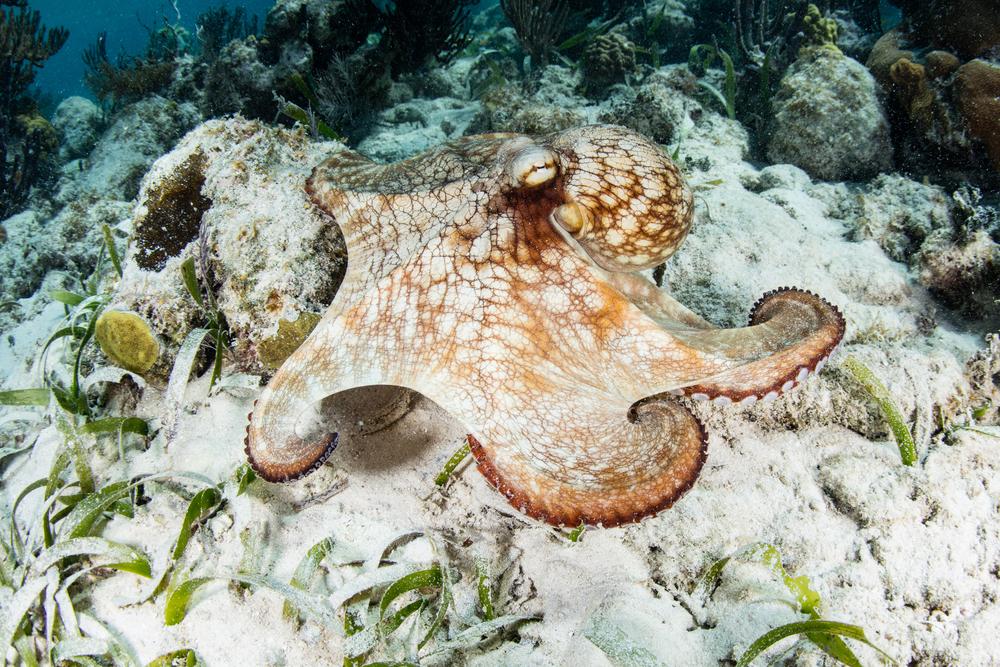
8. Caribbean reef octopus: Bonaire
Living (unsurprisingly) in the Caribbean Sea – as well as neighboring waters as far as northern South America – this iridescent species of octopus certainly brings glamor to the world of mollusks. Like other cephalopods, the Caribbean reef octopus (Octopus briareus) uses special pigment cells to mirror its surroundings, and lucky divers might witness a kaleidoscopic show of oranges, pinks, purples, blues, and greens.
The Caribbean reef octopus is also an accomplished stalker with a particularly menacing technique. Using its webbed arms like a net, it drapes itself over the reef, trapping unsuspecting victims. Prey includes crustaceans, gastropods, and clams. The Caribbean reef octopus is just as foreboding when other octopuses dare to enter its habitat. Invasions usually result in a fight to the death and occasional cannibalism.
Our favorite Caribbean Reef octopus destination:
With calm conditions and second-to-none shore diving, Bonaire is one of the top scuba diving destinations. It’s also one of the best destinations for octopus dives, as well as various species of turtle, seahorses, and tons of colorful reef fish, including angelfish, tangs, sergeant majors, and butterflyfish. Don’t miss the opportunity for a night dive in this area; the Caribbean reef octopus is nocturnal, so this will give you the best chances of an encounter.
Editor’s Recommended Dive Resort: Buddy Dive Resort
Discover the best destinations for octopus sightings
These eight destinations and species are just the tip of the iceberg when it comes to discovering the wonder of octopuses. If these inspire you to photograph blue-ringed octopuses in Malaysia or relish the comedy of coconut octopuses in Indonesia, get ready to turn your scuba bucket list into reality.
Our scuba travel experts are ready 24/7 by email, phone, and web chat to help you book your dream, octopus-filled scuba vacation. Head over to PADI Travel today to get started!
Related Reading:
- Facts About Octopuses That Prove They’re Aliens
- Best Octopus Halloween Costumes
- Creature Feature: Giant Pacific Octopus
- OctoGirl: Using Scuba Diving to Conduct Octopus PhD Research
- How Do Octopuses Camouflage?

